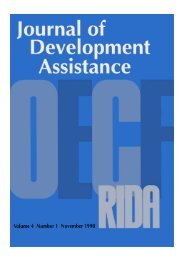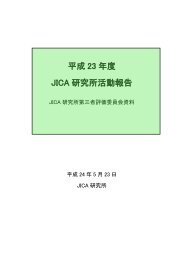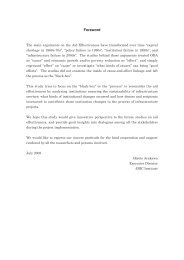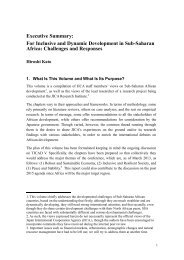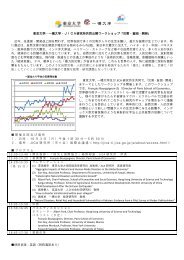Koichi Fujita.pdf - JICA Research Institute
Koichi Fujita.pdf - JICA Research Institute
Koichi Fujita.pdf - JICA Research Institute
You also want an ePaper? Increase the reach of your titles
YUMPU automatically turns print PDFs into web optimized ePapers that Google loves.
Green Revolution in India and Its Significance in<br />
Economic Development:<br />
Implications for sub-Saharan Africa<br />
IPD, Fourth Task Force on Africa<br />
Pretoria, July 10, 2009<br />
<strong>Koichi</strong> FUJITA<br />
Center for Southeast Asian Studies<br />
Kyoto University, Japan
Objectives of the paper<br />
• To analyze the historical role of the Green Revolution<br />
in South Asia (especially in India) in its overall<br />
economic development process<br />
• To show the logic why Green Revolution is essential<br />
before starting sustainable economic development<br />
with industrialization<br />
• To consider the possibilities of Green Revolution in<br />
the context of contemporary sub-Saharan Africa
Accelerated economic growth in India after the 1990s<br />
Impact of liberalization policies<br />
→ Role of the agricultural development in the 1980s
Food production, net export, and population in India<br />
Neglect of agriculture<br />
↑<br />
1 st Green Rev.<br />
=Lost decade<br />
Severe droughts<br />
2 nd Green Rev.
Wheat as a minor crop to a dominant crop<br />
100.00<br />
90.00<br />
80.00<br />
70.00<br />
60.00<br />
50.00<br />
40.00<br />
30.00<br />
20.00<br />
10.00<br />
0.00<br />
Million tons<br />
2000/01<br />
1950/51<br />
1952/53<br />
1954/55<br />
1956/57<br />
1958/59<br />
1960/61<br />
1962/63<br />
1964/65<br />
1966/67<br />
1968/69<br />
1970/71<br />
1972/73<br />
1974/75<br />
1976/77<br />
1978/79<br />
1980/81<br />
1982/83<br />
1984/85<br />
1986/87<br />
1988/89<br />
1990/91<br />
1992/93<br />
1994/95<br />
1996/97<br />
1998/99<br />
2002/03<br />
2004/05<br />
2006/07<br />
Rice<br />
Wheat<br />
Coarse grains<br />
Maize<br />
Eastern and Southern<br />
Northern and Western<br />
Year
Wheat Revolution in India
Nationwide agricultural development in the 1980s<br />
Table 1 Growth Rate of Crop Production in India<br />
1950~60 1960~70 1970~80 1980~90 1990~96<br />
Rice 4.53 2.12 1.73 4.08 1.60<br />
Wheat 5.79 7.73 4.15 4.29 3.64<br />
Coarse grains 3.76 1.67 0.55 0.71 -0.99<br />
Maize 7.84 3.90 0.64 3.20 1.30<br />
Total 4.45 3.10 2.07 3.38 1.81<br />
Pulses 3.80 -0.47 -1.18 2.45 -0.07<br />
Total Foodgrains 4.35 2.63 1.76 3.31 1.66<br />
Oilseeds 3.05 2.41 1.34 6.01 4.16<br />
Sugarcane 5.62 2.54 2.27 4.38 3.72<br />
Cotton 4.54 2.03 2.69 3.23 4.51<br />
Jute/Mesta 5.60 0.32 2.13 1.28 2.18<br />
Note.The data are three year moving averages.<br />
Rice Revolution in eastern and southern India and oilseeds and cotton<br />
revolutions in hitherto coarse grain producing areas.
Rice Revolution in the 1980s<br />
50<br />
45<br />
40<br />
Sown area (million ha)<br />
Yield (100kg/ha)<br />
Irrigated Ratio(%)<br />
Sown area<br />
60<br />
50<br />
Million hecrate, 100kg/ha<br />
35<br />
30<br />
25<br />
20<br />
15<br />
10<br />
Yield<br />
Irrigated<br />
ratio(right)<br />
↑Tube-wells<br />
40<br />
30<br />
20<br />
10<br />
5<br />
0<br />
0<br />
1950/51<br />
1960/61<br />
1970/71<br />
1980/81<br />
1990/91<br />
2000/01<br />
2003/04<br />
*<br />
↓ high growth<br />
%
Minor irrigation development in India<br />
( 1000 ha )<br />
20000<br />
18000<br />
16000<br />
14000<br />
12000<br />
10000<br />
8000<br />
6000<br />
Canal(Gov.)<br />
Tube-well<br />
Other well<br />
4000<br />
2000<br />
0<br />
Tank<br />
Others<br />
Canal(Private)<br />
1960/61 1970/71 1980/81 1990/91 1995/96(p)<br />
( Year )
Great divergence between South Asia and sub-Saharan<br />
Africa in the 1980s<br />
Per capita calorie intake in developing countries<br />
South Asia<br />
Rising real wages<br />
Reduction of rural<br />
poverty<br />
sub-Saharan Africa
Essence of Indian (and Bangladesh) experience<br />
• In the 1980s rice Revolution in eastern (including Bangladesh)<br />
and southern India and yellow Revolution (oilseeds) in central<br />
India was taken place, which raised rural income and alleviate<br />
poverty to a certain extent.<br />
• The engine of rice Revolution was the introduction of tubewell<br />
irrigation in hitherto rain-fed rice growing areas.<br />
• Tube-well irrigation induced a widespread emergence and<br />
development of ‘groundwater market’, which was basically an<br />
efficient rural institution.
Logic of Green Revolution’s role in economic development<br />
• Nationwide agricultural growth with productivity growth<br />
↓<br />
• Uplifting income of majority of population (rural population)<br />
‘to a certain level’<br />
↓<br />
• Thus creating a large ‘market’ for non-agricultural products<br />
and services<br />
↓<br />
• Development of non-agricultural sector in a sustainable<br />
manner
Implications for sub-Saharan Africa I<br />
• The key is how to raise income of majority of population to a<br />
certain extent<br />
• Is a Green Revolution possible in sub-Saharan Africa<br />
• Disadvantages:<br />
1) Diversity of staple food (wheat and rice is relatively minor crop<br />
for farmers)<br />
2) Almost totally rain-fed<br />
3) Difference in food preference between rural and urban areas<br />
4) Labor scarcity (still) in rural areas<br />
5) Small market size for industrialization (small poor countries)
Implications for sub-Saharan Africa II<br />
• The most prospective is a rice Green Revolution<br />
• Possibility of NERICA (New Rice for Africa)<br />
• May not be a widespread Green Revolution in rural Africa, but<br />
at least contribute to a substantial decrease of rice imports<br />
• Importance of investment for agriculture in addition to<br />
investment in agriculture
Thank you<br />
for your attention !


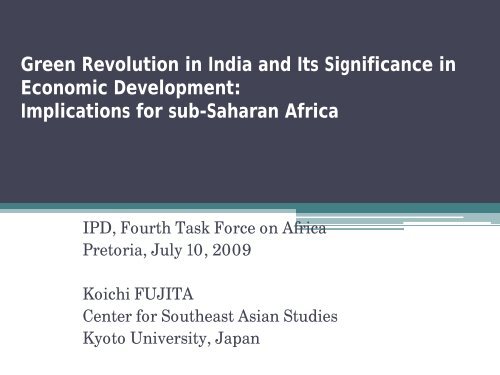
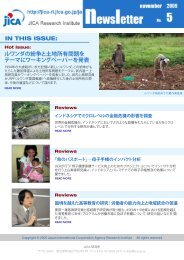


![新たな時代の開発 [寄稿]我が国製造業の競争パフォーマンス 欧州に ...](https://img.yumpu.com/45564809/1/185x260/-.jpg?quality=85)


